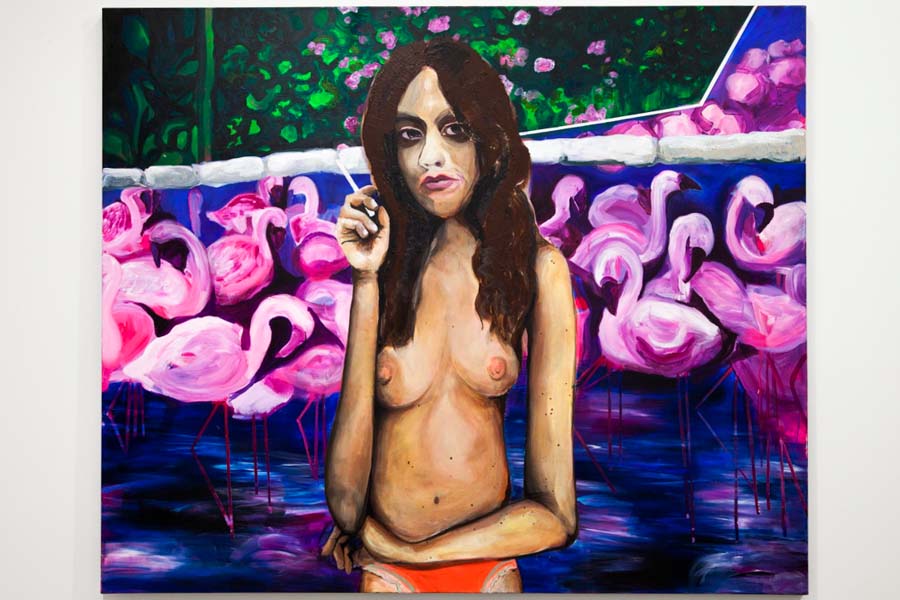Feminism has made great strides in the past hundred years, but women today are still criticized for owning their own bodies and controlling their sexuality. Montreal artist Gabrielle Lajoie-Bergeron questions the arbitrary limits imposed on women’s sexual autonomy in her new exhibit “LOVE ME, Love My Doll” at La Centrale Galerie Powerhouse. Lajoie-Bergeron, who studied at both Université Laval and Universite du Quebec à Montreal (UQAM), explores modern definitions of femininity in Western society in her work, as well as the binding effect these expectations can have on women as they grow up.
Upon entering the gallery, one is greeted by a young woman who stands in a fountain, sharing the water with a slew of flamingos and flower bushes. The large painting nearly spans from the floor to the ceiling in height. Naked, except for a pair of bright magenta lace underwear, the girl wears a nonchalant expression on her face – eyes dimmed, accompanied by dark circles underneath. Her arms are folded across her stomach, and in one hand, a cigarette is perched between two fingers. Carelessly smoking and making bold eye contact with the viewer, she exemplifies what it means for a woman to own her body without shame.
The girl in this painting is unfazed by her own nudity, her nonchalance a rebellion against these gendered double standards of sexual autonomy.
Yet another layer to this painting is the question of sexualization and objectification of women’s bodies. A girl who is simply standing naked in a fountain is not necessarily doing so sexually. But the fact that her chest is bare would likely be perceived as such and deemed inappropriate by many audiences. Women’s bodies are endlessly sexualized by society and in turn by the media, making topless women universally taboo, sexual objects, while topless men are not. The girl in this painting is unfazed by her own nudity, her nonchalance a rebellion against these gendered double standards of sexual autonomy.
Many other works, of various smaller sizes, echo similar themes. In one painting, a young girl straddles a gymnastics vault, wearing a pink and white leotard with a pink bow in her hair to match. Between her legs, protruding out of her vagina, is a yellow rose, symbolic of popular perceptions of virginity and ‘sexual innocence.’ Flowers are frequently associated with the so-called loss (or taking) of sexual innocence, as reflected by the term ‘de-flowering.’ Virginity is often accepted in Western society as the only barrier between childhood and womanhood, despite the heteronormative implications. The flower protruding from the young girl’s open legs in a particularly suggestive manner is jarring; it vividly criticizes the pressure to maintain a flower-like delicacy and a ‘youthful innocence’ while also feeling pressure to gain sexual experience.
The scariest part about the harmful beauty standards that these Barbie dolls promote is that they are directed at young girls.
Beyond treading this supposed line between girlhood and womanhood, Lajoie-Bergeron also questions the beauty standards placed on women of all ages. A rectangular poster is depicted within one painting, creating a ‘picture-within-a-picture’ effect. The poster within the painting presents an intricate drawing of two statuesque women casually leaning against a wall. Their faces and bodies are drawn ornately – with high cheekbones, piercing eyes, large breasts, and very long, thin legs – and represent the arbitrary and harmful beauty standards that box in women and girls. In the same painting, a girl who is drawn to appear less ornate and less conventionally ‘attractive’ looks at the poster girls, suggesting the powerful role the media plays in perpetuating standards of beauty and femininity. The girl and her gaze exemplify the dichotomy between the arbitrary standards of beauty to which women are compared, and the diverse reality of women’s figures.
A nearby painting expands on this theme, depicting eight blonde Barbie dolls in identical striped bathing suits. They each wear high ponytails and similar makeup – pink cheeks painted on fair white skin, dark eyeshadow, and red lipstick. The scariest part about the harmful beauty standards that these Barbie dolls promote is that they are directed at young girls.
Through every piece in the exhibit, Lajoie-Bergeron puts forward her own stance on sexuality and female autonomy. She critiques these socially normative definitions of beauty and femininity by playing on experience, showing viewers what it feels like to be trapped within the dichotomy of girl and woman, and in doing so, empowers audiences to break free.
“LOVE ME, Love My Doll” runs until April 10 at La Centrale Galerie Powerhouse.

